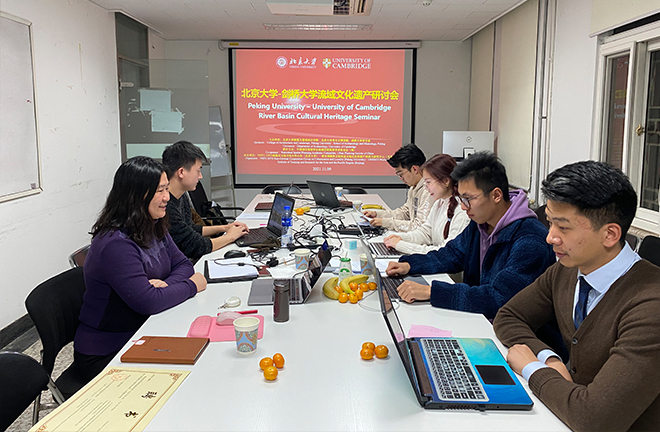Seminar explores cultural heritage of river basin

A seminar on river basin cultural heritage takes place, combining on-site panels and video links, in Beijing on Nov. 9. Photo: Yang Yiming/CSST
The Peking University-University of Cambridge River Basin Cultural Heritage Seminar was held in Beijing on Nov. 9. Scholars held discussions on the theory and practice of cultural heritage protection, the role of rivers in prehistory, and the protection of river basin cultural heritage.
River basin and regional development
In the human-environment system, river basins were the earliest geographical unit of human activities, said Wang Fang, a professor from the College of Architecture and Landscape at Peking University. The evolution of a region’s water system is inextricably linked with its development, the two together constituting a complex coupled human-environment system primarily in a “people-water-environment” form. The heritage of a river basin contributes an important topic in the study of the man-land relationship, and is of great significance to the construction of “a community of life” for man and nature.
The rise of most ancient civilizations benefited from great river basins, said Shen Ruiwen, dean of the School of Archaeology and Museology at Peking University. The profound wisdom of ancient river basin culture was demonstrated everywhere, such as the familiar historical allusion of “Yu the Great taming the flood” and the well-known quote “the supreme good is like water”[ from Tao Te Ching].
In the course of promoting high-quality economic development, how to break the restrictions of administrative divisions, make development plans, and allocate resources in accordance with more complete regional units such as river basins is relevant for the era. Shi Nan, secretary-general of the Urban Planning Society of China, noted that research on the cultural heritage of river basins is one of the critical links in planning and configuration, which is, in addition to a major research direction for archaeology, also a focus of urban and rural planning.
Amid the current trend of urbanization and due to the complex natural environment and human factors, the protection of river basin cultural heritage is faced with practical problems such as the pressure on the ecological environment’s carrying capacity, the huge difference in socio-economic levels, environmental convergence, and the fading away of memory. In this regard, Lyu Bin, a professor from the School of Urban and Environmental Sciences at Peking University, suggested starting from the natural and humanistic coupling and considering the overall coordination of basins to achieve high-quality development. Efforts are also necessary to transcend the barriers of natural sciences and the humanities, and, from a multi-disciplinary and multi-system perspective, promote the sustainable development of river basin cultural heritage. Then from a practical perspective, national strategic deployment needs further improvement to enrich the existing territorial space planning system.
Heritage protection has not yet become a consensus of the whole society. Marie Louise Stig Sørensen, a professor from the Department of Archaeology at the University of Cambridge, pointed out the functions of rivers in prehistoric times—cultural dissemination, security and defense, and wealth creation. Weighing heavily in politics and economy, rivers probably dominated people’s worldview at that time.
Archaeological culture of basins
The Bronze Age culture in the Liao River basin belongs to five different cultural systems, which present a cultural development pattern from parallel to interactive. Archaeologists have grouped them into two different phenomena: one is represented by the southern Liaodong region, in which archaeological cultures not only have a chronological relationship, but also belong to the same culture created by the same ethnic group or community in the same area at different times; the other type of archaeological cultures within the area, while also in chronological order, is created by different ethnic groups or communities in the same area at different times.
According to Zhao Binfu, a professor from the School of Archaeology at Jilin University, if the first type of area is called the “serial cultural area” and the second type the “sequential cultural area,” these two different types of cultural areas are two commonly seen archeological phenomena, the revelation of which offers reference for the study of the evolution and interaction of ancient archaeological cultures in river basins in other parts of China and the world.
There are still many unsolved mysteries concerning the protection and research of river basin cultural heritage, said Huo Wei, a professor from the School of History and Culture at Sichuan University. When it comes to the status quo of Sanxingdui research and publicity, having a deeper understanding of the Sanxingdui culture requires further archaeological investigations inside and outside the Sanxingdui city site to find more new archaeological clues. Expediting the construction of a new Sanxingdui museum is an effective way to relieve the current pressure of streams of people crowding into the Sanxingdui Museum. A greater intensity of interpretation and value transformation is needed to push academic achievements from the ivory tower to the outside world, which is an important path for the cultural value and heritage value embodied in Sanxingdui to be delivered to the public.
Edited by YANG LANLAN
